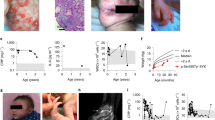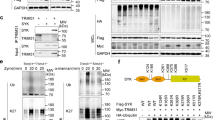Abstract
Spleen tyrosine kinase (Syk) is expressed widely in hematopoietic and non-hematopoietic cells. The widespread distribution of Syk and its involvement in host defense and allergic reactions, prompted us analyze the influence of microbial exposure on Syk expression. We compared the distribution of Syk in various tissues of germ-free and conventional mice using immunohistochemistry, Western blot analysis and real time RT-PCR. Total Syk expression was similar between germ-free and conventional mice. Since it has been claimed that Syk isoforms are differentially expressed, we studied the distribution and abundance of Syk (L) and Syk (S) isoforms in tissues from these mice. In contrast to previous reports, we found broad tissue expression of Syk (S). Interestingly, in germ-free mice the amount of Syk (S) but not Syk L protein was selectively increased in lung and spleen. In summary, our study reveals new and broad tissue expression of both Syk isoforms and demonstrates that lack of microbial flora results in selectively increased expression of Syk (S) isoform in lung and spleen.






Similar content being viewed by others
References
Berin MC, Dwinell MB, Eckmann L, Kagnoff MF (2001) Production of MDC/CCL22 by human intestinal epithelial cells. Am J Physiol Gastrointest Liver Physiol 280:G1217–G1226
Bosma MJ, Makinodan T, Walburg HE Jr (1967) Development of immunologic competence in germfree and conventional mice. J Immunol 99:420–430
Cheng AM, Rowley B, Pao W, Hayday A, Bolen JB, Pawson T (1995) Syk tyrosine kinase required for mouse viability and B-cell development. Nature 378:303–306
Coates E, Marie GBE (1984) The germ-free animal in biomedical research. Laboratory Animals Ltd, London
Coopman PJ, Do MT, Barth M, Bowden ET, Hayes AJ, Basyuk E, Blancato JK, Vezza PR, McLeskey SW, Mangeat PH, Mueller SC (2000) The Syk tyrosine kinase suppresses malignant growth of human breast cancer cells. Nature 406:742–747
Crabbé PA, Nash DR, Bazin H, Eyssen H, Heremans JF (1970) Immunohistochemical observations on lymphoid tissues from conventional and germ-free mice. Lab Invest 22:448–457
Faccio R, Teitelbaum SL, Fujikawa K, Chappel J, Zallone A, Tybulewicz VL, Ross FP, Swat W (2005) Vav3 regulates osteoclast function and bone mass. Nat Med 11:284–290
Fluck M, Zurcher G, Andres AC, Ziemiecki A (1995) Molecular characterization of the murine syk protein tyrosine kinase cDNA, transcripts and protein. Biochem Biophys Res Commun 213:273–281
Gatalica Z, Bing Z (2005) Syk tyrosine kinase expression during multistep mammary carcinogenesis. Croat Med J 46:372–376
Hansbro PM, Beagley KW, Horvat JC, Gibson PG (2004) Role of atypical bacterial infection of the lung in predisposition/protection of asthma. Pharmacol Ther 101:193–210
Harrison ML, Isaacson CC, Burg DL, Geahlen RL, Low PS (1994) Phosphorylation of human erythrocyte band 3 by endogenous p72syk. J Biol Chem 269:955–959
Hooper DC, Molowitz EH, Bos NA, Ploplis VA, Cebra JJ (1995) Spleen cells from antigen-minimized mice are superior to spleen cells from germ-free and conventional mice in the stimulation of primary in vitro proliferative responses to nominal antigens. Eur J Immunol 25:212–217
Indik ZK, Park JG, Hunter S, Schreiber AD (1995) The molecular dissection of Fc gamma receptor mediated phagocytosis. Blood 86:4389–4399
Jung HC, Eckmann L, Yang SK, Panja A, Fierer J, Morzycka-Wroblewska E, Kagnoff MF (1995) A distinct array of proinflammatory cytokines is expressed in human colon epithelial cells in response to bacterial invasion. J Clin Invest 95:55–65
Latour S, Chow LM, Veillette A (1996) Differential intrinsic enzymatic activity of Syk and Zap-70 protein-tyrosine kinases. J Biol Chem 271:22782–22790
Moroni M, Soldatenkov V, Zhang L, Zhang Y, Stoica G, Gehan E, Rashidi B, Singh B, Ozdemirli M, Mueller SC (2004) Progressive loss of Syk and abnormal proliferation in breast cancer cells. Cancer Res 64:7346–7354
Negro A, Brunati AM, Donella-Deana A, Massimino ML, Pinna LA (2002) Multiple phosphorylation of alpha-synuclein by protein tyrosine kinase Syk prevents eosin-induced aggregation. FASEB J 16:210–212
Oliver JM, Kepley CL, Ortega E, Wilson BS (2000) Immunologically mediated signaling in basophiles and mast cells: finding therapeutic targets for allergic diseases in the human FcvarepsilonR1 signaling pathway. Immunopharmacology 48:269–281
Romagnani S (2004) The increased prevalence of allergy and the hygiene hypothesis: missing immune deviation, reduced immune suppression, or both? Immunology 112:352–363
Ruschel A, Ullrich A (2004) Protein tyrosine kinase Syk modulates EGFR signalling in human mammary epithelial cells. Cell Signal 16:1249–1261
Sada K, Takano T, Yanagi S, Yamamura H (2001) Structure and function of Syk protein-tyrosine kinase. J Biochem (Tokyo) 130:177–186
Sedlik C, Orbach D, Veron P, Schweighoffer E, Colucci F, Gamberale R, Ioan-Facsinay A, Verbeek S, Ricciardi-Castagnoli P, Bonnerot C, Tybulewicz VL, Di Santo J, Amigorena S (2003) A critical role for Syk protein tyrosine kinase in Fc receptor-mediated antigen presentation and induction of dendritic cell maturation. J Immunol 170:846–852
Seibert K, Pollard M, Nordin A (1974) Some aspects of humoral immunity in germ-free and conventional SJL-J mice in relation to age and pathology. Cancer Res 34:1707–1719
Stenton GR, Kim MK, Nohara O, Chen CF, Hirji N, Wills FL, Gilchrist M, Hwang PH, Park JG, Finlay W, Jones RL, Befus AD, Schreiber AD (2000) Aerosolized Syk antisense suppresses Syk expression, mediator release from macrophages, and pulmonary inflammation. J Immunol 164:3790–3797
Stenton GR, Ulanova M, Dery RE, Merani S, Kim MK, Gilchrist M, Puttagunta L, Musat-Marcu S, James D, Schreiber AD, Befus AD (2002) Inhibition of allergic inflammation in the airways using aerosolized antisense to Syk kinase. J Immunol 169:1028–1036
Toyama T, Iwase H, Yamashita H, Hara Y, Omoto Y, Sugiura H, Zhang Z, Fujii Y (2003) Reduced expression of the Syk gene is correlated with poor prognosis in human breast cancer. Cancer Lett 189:97–102
Tsuchida S, Yanagi S, Inatome R, Ding J, Hermann P, Tsujimura T, Matsui N, Yamamura H (2000) Purification of a 72-kDa protein-tyrosine kinase from rat liver and its identification as Syk: involvement of Syk in signaling events of hepatocytes. J Biochem (Tokyo) 127:321–327
Tsuge T, Suzuki Y, Shimokawa T, Horikoshi S, Okumura K, Ra C, Tomino Y (2003) Monocyte chemoattractant protein (MCP)-1 production via functionally reconstituted Fcalpha receptor (CD89) on glomerular mesangial cells. Inflamm Res 52:428–432
Tsujimura T, Yanagi S, Inatome R, Takano T, Ishihara I, Mitsui N, Takahashi S, Yamamura H (2001) Syk protein-tyrosine kinase is involved in neuron-like differentiation of embryonal carcinoma P19 cells. FEBS Lett 489:129–133
Turner M, Gulbranson-Judge A, Quinn ME, Walters AE, MacLennan IC, Tybulewicz VL (1997) Syk tyrosine kinase is required for the positive selection of immature B cells into the recirculating B cell pool. J Exp Med 186:2013–2021
Turner M, Schweighoffer E, Colucci F, Di Santo JP, Tybulewicz VL (2000) Tyrosine kinase SYK: essential functions for immunoreceptor signalling. Immunol Today 21:148–154
Ulanova M, Puttagunta L, Kim MK, Schreiber AD, Befus AD (2003) Antisense oligonucleotides to Syk kinase: a novel therapeutic approach for respiratory disorders. Curr Opin Investig Drugs 4:552–555
Ulanova M, Puttagunta L, Marcet-Palacios M, Duszyk M, Steinhoff U, Duta F, Kim MK, Indik ZK, Schreiber AD, Befus AD (2005a) Syk tyrosine kinase participates in beta1-integrin signaling and inflammatory responses in airway epithelial cells. Am J Physiol Lung Cell Mol Physiol 288:L497–L507
Ulanova M, Duta F, Puttagunta L, Schreiber AD, Befus DA (2005b) Spleen tyrosine kinase (Syk) as a novel target for allergic asthma and rhinitis. Expert Opin Ther Targets 9(5):901–21
Van Oudenaren A, Haaijman JJ, Benner R (1984) Frequencies of background cytoplasmic Ig-containing cells in various lymphoid organs of athymic and euthymic mice as a function of age and immune status. Immunology 51:735–742
Wang L, Duke L, Zhang PS, Arlinghaus RB, Symmans WF, Sahin A, Mendez R, Dai JL (2003) Alternative splicing disrupts a nuclear localization signal in spleen tyrosine kinase that is required for invasion suppression in breast cancer. Cancer Res 63:4724–4730
Wang S, Ding YB, Chen GY, Xia JG, Wu ZY (2004) Hypermethylation of Syk gene in promoter region associated with oncogenesis and metastasis of gastric carcinoma. World J Gastroenterol 10:1815–1818
Yamada T, Fujieda S, Yanagi S, Yamamura H, Inatome R, Sunaga H, Saito H (2001) Protein-tyrosine kinase Syk expressed in human nasal fibroblasts and its effect on RANTES production. J Immunol 166:538–543
Yanagi S, Inatome R, Ding J, Kitaguchi H, Tybulewicz VL, Yamamura H (2001a) Syk expression in endothelial cells and their morphologic defects in embryonic Syk-deficient mice. Blood 98:2869–2871
Yanagi S, Inatome R, Takano T, Yamamura H (2001b) Syk expression and novel function in a wide variety of tissues. Biochem Biophys Res Commun 288:495–498
Yuan Y, Mendez R, Sahin A, Dai JL (2001) Hypermethylation leads to silencing of the SYK gene in human breast cancer. Cancer Res 61:5558–5561
Yuan Y, Liu H, Sahin A, Dai JL (2005) Reactivation of SYK expression by inhibition of DNA methylation suppresses breast cancer cell invasiveness. Int J Cancer 113:654–659
Acknowledgments
We thank Karl Fisher (University of Alberta) for helping us with the Western blot protocol, Thomas Turner (Laboratory Medicine and Pathology, University of Alberta) for technical support with pictures and also Bilan Li (Lovelace Respiratory Research Institute, Albuquerque) for technical assistance with cell transfection experiments. This work was supported by NIH 5 R 01 HL 069498 to Drs. A. D. Schreiber and A. D. Befus; by Sonderforschungsbereich SFB 633 to Dr. U. Steinhoff; by HL 071547 to Dr. K. Harrod.
Author information
Authors and Affiliations
Corresponding authors
Additional information
Florentina Duta, Marina Ulanova and Daniel Seidel are joint first authors. Ulrich Steinhoff and A. Dean Befus are joint last authors.
M. Ulanova received a postdoctoral fellowship from the Canadian Society of Allergy and Clinical Immunology/Merck Frosst and from the Alberta Heritage Foundation for Medical Research.
Rights and permissions
About this article
Cite this article
Duta, F., Ulanova, M., Seidel, D. et al. Differential expression of spleen tyrosine kinase Syk isoforms in tissues: effects of the microbial flora. Histochem Cell Biol 126, 495–505 (2006). https://doi.org/10.1007/s00418-006-0188-z
Accepted:
Published:
Issue Date:
DOI: https://doi.org/10.1007/s00418-006-0188-z




